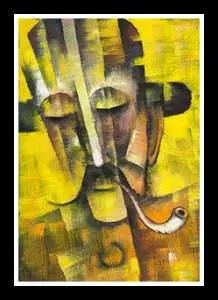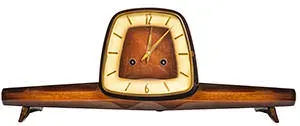 The Art Deco period ran from approximately 1920 to 1935. It was a time full of gangsters, speakeasies, flappers, and great style. During the roaring 20's, jazz became quite popular and the economy boomed. The 20's was a decade of joy, prosperity, celebration, and hope towards the future. Art Deco style was symbolic of this strong economy. It was embraced with a passion, representing everything luxurious and beautiful, as well as the people's faith in social and technological progress.
The Art Deco period ran from approximately 1920 to 1935. It was a time full of gangsters, speakeasies, flappers, and great style. During the roaring 20's, jazz became quite popular and the economy boomed. The 20's was a decade of joy, prosperity, celebration, and hope towards the future. Art Deco style was symbolic of this strong economy. It was embraced with a passion, representing everything luxurious and beautiful, as well as the people's faith in social and technological progress.
 The name �Art Deco,� comes from the short version of �Arts D�coratifs,� from the Exposition Internationale des Arts D�coratifs et Industriels Modernes (The International Exposition of Modern Decorative and Industrial Arts) which was held in Paris in 1925. This was an exhibit showcasing the most popular French artists of the time. Calling this period of time �Art Deco� was not common until 1968, when the English art historian Bevis Hillier wrote his definitive book, "Art Deco of the 20s and 30s."" Hillier defined Art Deco as ""an assertively modern style [that] ran to symmetry rather than asymmetry, and to the rectilinear rather than the curvilinear; it responded to the demands of the machine and of new material [and] the requirements of mass production"". The term Art Deco has since been applied to a wide variety of works not only produced in France, but everywhere during the Interwar period- for example Bauhaus work from Germany. Art Deco however, will always be known to have originated in France."
The name �Art Deco,� comes from the short version of �Arts D�coratifs,� from the Exposition Internationale des Arts D�coratifs et Industriels Modernes (The International Exposition of Modern Decorative and Industrial Arts) which was held in Paris in 1925. This was an exhibit showcasing the most popular French artists of the time. Calling this period of time �Art Deco� was not common until 1968, when the English art historian Bevis Hillier wrote his definitive book, "Art Deco of the 20s and 30s."" Hillier defined Art Deco as ""an assertively modern style [that] ran to symmetry rather than asymmetry, and to the rectilinear rather than the curvilinear; it responded to the demands of the machine and of new material [and] the requirements of mass production"". The term Art Deco has since been applied to a wide variety of works not only produced in France, but everywhere during the Interwar period- for example Bauhaus work from Germany. Art Deco however, will always be known to have originated in France."
 Art Deco style, which can be seen in art, architecture, clothing, and jewelry, combines Machine Age imagery and materials with rich colors, and most importantly, bold geometric shapes. The post-war society very quickly fell in love with the style, as it was a representation of all that was modern, luxurious and beautiful.
Art Deco style, which can be seen in art, architecture, clothing, and jewelry, combines Machine Age imagery and materials with rich colors, and most importantly, bold geometric shapes. The post-war society very quickly fell in love with the style, as it was a representation of all that was modern, luxurious and beautiful.
 While Art Deco jewelry referenced geometry and machines, the style was also influenced by styles of fine art, such as Futurism and Cubism. Many fine artists influenced jewelry styles, for example Pablo Picasso, Georges Braque, and Jean Dubuffet.
While Art Deco jewelry referenced geometry and machines, the style was also influenced by styles of fine art, such as Futurism and Cubism. Many fine artists influenced jewelry styles, for example Pablo Picasso, Georges Braque, and Jean Dubuffet.
 Jewelry styles during the Art Deco period were more sharp, bold and masculine than they ever were in any other time. The use of futuristic motifs and geometric lines reflected the confident spirit of the time. Diamonds were extremely popular in the Art Deco age, as were rubies, sapphires and emeralds. One defining style of the period was the use of black
Jewelry styles during the Art Deco period were more sharp, bold and masculine than they ever were in any other time. The use of futuristic motifs and geometric lines reflected the confident spirit of the time. Diamonds were extremely popular in the Art Deco age, as were rubies, sapphires and emeralds. One defining style of the period was the use of black ![]() onyx in contrast with the white diamonds. Some of the great jewelry houses, such as Van Cleef & Arpels, Cartier, and Tiffany created some of their most iconic pieces during this time.
onyx in contrast with the white diamonds. Some of the great jewelry houses, such as Van Cleef & Arpels, Cartier, and Tiffany created some of their most iconic pieces during this time.
 Many innovations in the way jewelry was made occurred during this time. New cuts and shapes of gemstones and diamonds allowed jewelers to create extremely detailed and beautiful mosaic-like designs. Diamonds began to be cut in the modern, round brilliant style, which allowed them to appear more dazzling than ever before. Baguette diamonds were also introduced, as well as the French cut and the Asscher cut.
Many innovations in the way jewelry was made occurred during this time. New cuts and shapes of gemstones and diamonds allowed jewelers to create extremely detailed and beautiful mosaic-like designs. Diamonds began to be cut in the modern, round brilliant style, which allowed them to appear more dazzling than ever before. Baguette diamonds were also introduced, as well as the French cut and the Asscher cut.
 Platinum began to be used more because of its strength- it required less metal to hold a gem securely, therefore designs were lighter. Jewelers also began using white gold, which was more affordable than platinum and yellow gold, and looked almost identical to platinum. New casting techniques were also invented that allowed jewelers to produce extremely intricate designs. The most important and popular jewelry innovation of the time however, was the invisible setting, developed by Van Cleef & Arpels, where a gem was mounted through a system of grooves and rails in a way that no metal was visible.
Platinum began to be used more because of its strength- it required less metal to hold a gem securely, therefore designs were lighter. Jewelers also began using white gold, which was more affordable than platinum and yellow gold, and looked almost identical to platinum. New casting techniques were also invented that allowed jewelers to produce extremely intricate designs. The most important and popular jewelry innovation of the time however, was the invisible setting, developed by Van Cleef & Arpels, where a gem was mounted through a system of grooves and rails in a way that no metal was visible.
 Another process during this time resulted in pearls becoming the iconic jewel of the 1920's. This process involved implanting pearl-bearing oysters with mother of pearl beads to produce cultured pearls.
Another process during this time resulted in pearls becoming the iconic jewel of the 1920's. This process involved implanting pearl-bearing oysters with mother of pearl beads to produce cultured pearls.
 Art Deco rings were often massive and consisted of multiple platforms of assorted gemstones. Often, a large
Art Deco rings were often massive and consisted of multiple platforms of assorted gemstones. Often, a large ![]() diamond would be surrounded by a border of smaller diamonds, or the ring would have a colored stone with a cabochon cut in the center. Also extremely popular were large
diamond would be surrounded by a border of smaller diamonds, or the ring would have a colored stone with a cabochon cut in the center. Also extremely popular were large ![]() emerald cut diamond rings and step cut colored stones such as
emerald cut diamond rings and step cut colored stones such as ![]() aquamarine and emerald. Stacked rings were also popular- bands that were set all around with diamonds, rubies, emeralds and sapphires.
aquamarine and emerald. Stacked rings were also popular- bands that were set all around with diamonds, rubies, emeralds and sapphires.
 Brooches were another popular item of the Art Deco time, and they were attached to any item of clothing possible. Brooches were made of carved rock crystal
Brooches were another popular item of the Art Deco time, and they were attached to any item of clothing possible. Brooches were made of carved rock crystal ![]() quartz, coral,
quartz, coral, ![]() onyx and
onyx and ![]() jade. Asian motifs such as temples, pagodas, flowers and fountains were often seen on brooches. In the 1930's, the clip brooch became popular, usually worn in pairs, and designed so they could be joined into one larger brooch.
jade. Asian motifs such as temples, pagodas, flowers and fountains were often seen on brooches. In the 1930's, the clip brooch became popular, usually worn in pairs, and designed so they could be joined into one larger brooch.
 Watches were also extremely popular, designed like bracelets- set with diamonds, pearls and colored gemstones. Watches were so popular that they were added to lighters, and lipstick and cigarette cases. A purse watch was even designed, where a covered rectangle opened to reveal a dial when the two sides of the purse were pulled apart. Opening the purse would also wind the watch and when opened, it could be used as a bedside clock.
Watches were also extremely popular, designed like bracelets- set with diamonds, pearls and colored gemstones. Watches were so popular that they were added to lighters, and lipstick and cigarette cases. A purse watch was even designed, where a covered rectangle opened to reveal a dial when the two sides of the purse were pulled apart. Opening the purse would also wind the watch and when opened, it could be used as a bedside clock.
 Art Deco earrings were extremely feminine- geometric, long and dangling, to accentuate the new short hairdo's women were sporting. Most earrings were set with diamonds that led down to a larger colored gemstone at the bottom of each piece. Pendants were the quintessential Art Deco jewelry item, and were made in a wide variety of geometric shapes- from long geometric shapes covered in diamonds and colored stones, to zig zag designs influenced by Egyptian, Chinese and Indian cultures. Tassels and fringes often hung at the bottom of pendants which dangled from chains or silk cords.
Art Deco earrings were extremely feminine- geometric, long and dangling, to accentuate the new short hairdo's women were sporting. Most earrings were set with diamonds that led down to a larger colored gemstone at the bottom of each piece. Pendants were the quintessential Art Deco jewelry item, and were made in a wide variety of geometric shapes- from long geometric shapes covered in diamonds and colored stones, to zig zag designs influenced by Egyptian, Chinese and Indian cultures. Tassels and fringes often hung at the bottom of pendants which dangled from chains or silk cords.
 Accessories of every kind imaginable were extremely popular in the Art Deco period. Hair pins, compacts, tiaras, hatpins, evening bags, lipstick holders and cigarette holders were all covered in intricate, elegant designs.
Accessories of every kind imaginable were extremely popular in the Art Deco period. Hair pins, compacts, tiaras, hatpins, evening bags, lipstick holders and cigarette holders were all covered in intricate, elegant designs.